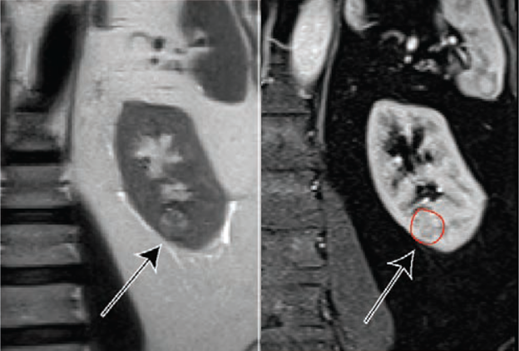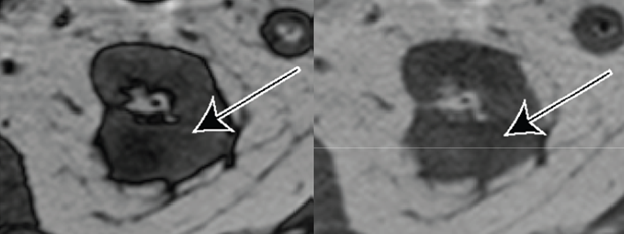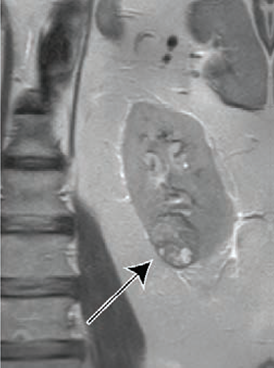MRI-Derived Score Helps Determine Renal Mass Growth Rate
The clear cell likelihood score can help providers determine the growth rate of masses that could be cancerous.
Using MRI to non-invasively capture a clear cell likelihood score (ccLS) can help providers better determine how quickly small kidney masses are growing. With this knowledge that can make better decisions about management strategies.
In a study published July 22 in the American Journal of Roentgenology, a team of investigators from the University of Texas Southwestern Medical Center showed that relying on MRI-derived ccLS rather than pre-operative percutaneous renal mass biopsy can effectively grade whether a mass will come back as renal cell carcinoma after evaluation.
ccLS scores are used to assess the likelihood that a small renal mass (equal to or less than 4 cm) is actually cancer with a score of 1 being unlikely and a score of 5 being very likely. The team, led by Ivan Pedrosa, M.D., Ph.D., professor of radiology and vice chair of radiology research, found that, based on their evaluations, higher ccLS scores correlate to more significant growth rates.
“The ccLS of small renal masses is significantly associated with growth. ccLS4-5 small renal masses grow more rapidly than ccLS1-2 and ccLS3 small renal masses,” the team said. “The information provided by ccLS may be beneficial in counseling patients and planning personalized management strategies.”
64-Year-Old Man With Clear Cell Likelihood Score (ccLS) 5 Renal Masses: Coronal T2-weighted single shot fast spin echo and coronal T1-weighted fat-saturated spoiled gradient echo acquired during corticomedullary phase—ccLS5 lesion outlined red for clarity.
Credit: American Journal of Roentgenology

This is the first study, the team said, that examines the correlation between ccLS and small renal mass growth.
For their retrospective study, the team evaluated ccLS scores derived from MRI scans conducted on 339 patients with an average age of 65 between June 2016 and November 2019. They examined tumor size measurements and tumor progression.
64-Year-Old Man With Clear Cell Likelihood Score (ccLS) 5 Renal Masses: Axial T1-weighted gradient echo opposed-phase and in-phase images.
Credit: American Journal of Roentgenology

Overall, the team looked at 386 small renal masses. They determined that ccLS was correlated with growth rate by size – ccLS4-5 of 9 percent annually and ccLS 1-2 by 5 percent annually – as well as by volume – ccLS4-5 by 29 percent annually and ccLS1-2 by 16 percent annually.
64-Year-Old Man With Clear Cell Likelihood Score (ccLS) 5 Renal Masses: Follow-up coronal T2-weighted single shot fast spin echo at 2.79 years. ccLS5 renal mass heterogeneously hyperintense with intense corticomedullary enhancement, presence of microscopic fat (i.e., drop in signal intensity on opposed-phase compared to in-phase), and significant interval growth (50.4%/year volume growth).
Credit: American Journal of Roentgenology

“Our study supports the conclusion of the more aggressive faster-growing nature of ccLS4-5 small renal masses. This…favors our recommendation of disease intervention in larger ccLS4-5 masses, in consideration of the patients’ clinical context and preferences,” the team said. “The results support the use of the ccLS as an ‘informational tool’ to assist with clinical decision making.”
In that vein, the team said they created an online calculator that patients and treating providers can use when making management decisions, helping them consider the likelihood of tumor growth in context with the patient’s life expectancy and co-morbidities.
For more coverage based on industry expert insights and research, subscribe to the Diagnostic Imaging e-Newsletter here.
Emerging AI Algorithm Shows Promise for Abbreviated Breast MRI in Multicenter Study
April 25th 2025An artificial intelligence algorithm for dynamic contrast-enhanced breast MRI offered a 93.9 percent AUC for breast cancer detection, and a 92.3 percent sensitivity in BI-RADS 3 cases, according to new research presented at the Society for Breast Imaging (SBI) conference.
Could AI-Powered Abbreviated MRI Reinvent Detection for Structural Abnormalities of the Knee?
April 24th 2025Employing deep learning image reconstruction, parallel imaging and multi-slice acceleration in a sub-five-minute 3T knee MRI, researchers noted 100 percent sensitivity and 99 percent specificity for anterior cruciate ligament (ACL) tears.
New bpMRI Study Suggests AI Offers Comparable Results to Radiologists for PCa Detection
April 15th 2025Demonstrating no significant difference with radiologist detection of clinically significant prostate cancer (csPCa), a biparametric MRI-based AI model provided an 88.4 percent sensitivity rate in a recent study.